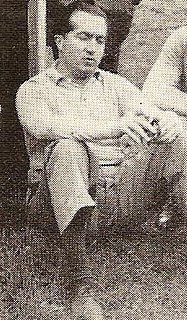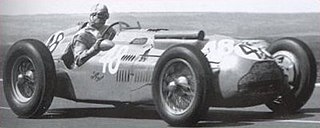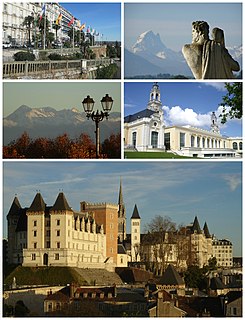
Alberto Ascari was an Italian racing driver and twice Formula One World Champion. He was a multitalented racer who competed in motorcycle racing before switching to cars. Ascari won consecutive world titles in 1952 and 1953 for Scuderia Ferrari. He was the team's first World Champion and the last Italian to date to win the title. This was sandwiched an appearance in the Indianapolis 500 in 1952. Ascari also won the Mille Miglia in 1954. Ascari was noted for the careful precision and finely-judged accuracy that made him one of the safest drivers in a most dangerous era. Ascari remains along with Michael Schumacher Ferrari's only back-to-back World Champions, and he is also Ferrari's sole Italian champion.

Jean-Pierre Wimille was a Grand Prix motor racing driver and a member of the French Resistance during World War II.
Grand Prix motor racing, a form of motorsport competition, has its roots in organised automobile racing that began in France as early as 1894. It quickly evolved from simple road races from one town to the next, to endurance tests for car and driver. Innovation and the drive of competition soon saw speeds exceeding 100 miles per hour (160 km/h), but because early races took place on open roads, accidents occurred frequently, resulting in deaths both of drivers and of spectators.
Maurice Bienvenu Jean Paul Trintignant was a motor racing driver and vintner from France. He competed in the Formula One World Championship for fourteen years, between 1950 and 1964, one of the longest careers in the early years of Formula One. During this time he also competed in sports car racing, including winning the 1954 24 Hours of Le Mans race. Following his retirement from the track Trintignant concentrated on the wine trade.

José Froilán González was an Argentine racing driver, particularly notable for scoring Ferrari's first win in a Formula One World Championship race at the 1951 British Grand Prix. He made his Formula One debut for Scuderia Achille Varzi in the 1950 Monaco Grand Prix. His last Grand Prix was the 1960 Argentine Grand Prix.

The 1951 French Grand Prix was a Formula One motor race held at Reims-Gueux on 1 July 1951. It was race 4 of 8 in the 1951 World Championship of Drivers and was won by Juan Manuel Fangio and Luigi Fagioli driving an Alfa Romeo. It was the first of three occasions where two drivers would be credited with a Grand Prix win after sharing a car.

Hermann Lang was a German racing driver who raced motorcycles, Grand Prix cars, and sports cars.
Jean Marie Behra was a Formula One driver who raced for the Gordini, Maserati, BRM, Ferrari and Porsche teams.

Luigi Villoresi was an Italian Grand Prix motor racing driver who continued racing on the Formula One circuit at the time of its inception.
Élie Marcel Bayol was a French racing driver who raced in Formula One for the O.S.C.A. and Gordini teams. He started his career in 1950 racing Monomill DB-Panhards and progressed to Formula 2 races and hillclimbs around France. His best result was a fourth place in the Circuit de Cadours, in 1951. In 1953 he was fourth again at Pau and obtained a pole position at Albi. He also succeeded the same year to win the Aix les Bains Circuit du Lac Grand Prix.

Philippe Étancelin was a French Grand Prix motor racing driver who joined the new Formula One circuit at its inception.

Guy Mairesse was a racing driver from France. He participated in 3 Formula One World Championship Grands Prix, debuting on 3 September 1950. He scored no championship points.

The Maserati 4CL and its derived sister model the Maserati 4CLT are single-seat racing cars that were designed and built by Maserati. The 4CL was introduced at the beginning of the 1939 season, as a rival to the Alfa Romeo 158 and various ERA models in the voiturette class of international Grand Prix motor racing. Although racing ceased during World War II, the 4CL was one of the front running models at the resumption of racing in the late 1940s. Experiments with two-stage supercharging and tubular chassis construction eventually led to the introduction of the revised 4CLT model in 1948. The 4CLT was steadily upgraded and updated over the following two years, resulting in the ultimate 4CLT/50 model, introduced for the inaugural year of the Formula One World Championship in 1950. In the immediate post-war period, and the first two years of the Formula One category, the 4CLT was the car of choice for many privateer entrants, leading to numerous examples being involved in most races during this period.
The 1950 Pau Grand Prix was a non-championship Formula One motor race held on 10 April 1950 at the Pau circuit, in Pau, Pyrénées-Atlantiques, France. It was the first race of the 1950 Formula One season, and was conducted on the same day as the 1950 Richmond Trophy. The 110-lap race was won by Maserati driver Juan Manuel Fangio after starting from pole position. Luigi Villoresi finished second in a Ferrari, and Louis Rosier third in a Talbot-Lago.

The 1952 Pau Grand Prix was a Formula Two motor race held on 14 April 1952 at the Pau circuit, in Pau, Pyrénées-Atlantiques, France. The Grand Prix served as the first round of the French Formula Two Championship and was won by Alberto Ascari, driving the Ferrari 500. Louis Rosier finished second and Jean Behra third.

The 1955 Pau Grand Prix was a non-championship Formula One motor race held on 11 April 1955 at the Pau circuit, in Pau, Pyrénées-Atlantiques, France. The Grand Prix was won by Jean Behra, driving the Maserati 250F. Eugenio Castellotti finished second and Roberto Mieres third.

The Ferrari 212 F1 was a Formula 1 and Formula 2 racing car designed by Aurelio Lampredi for Scuderia Ferrari in 1951.












